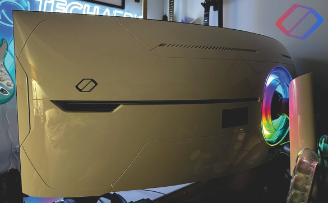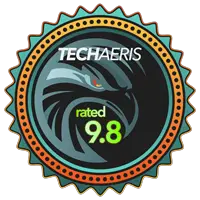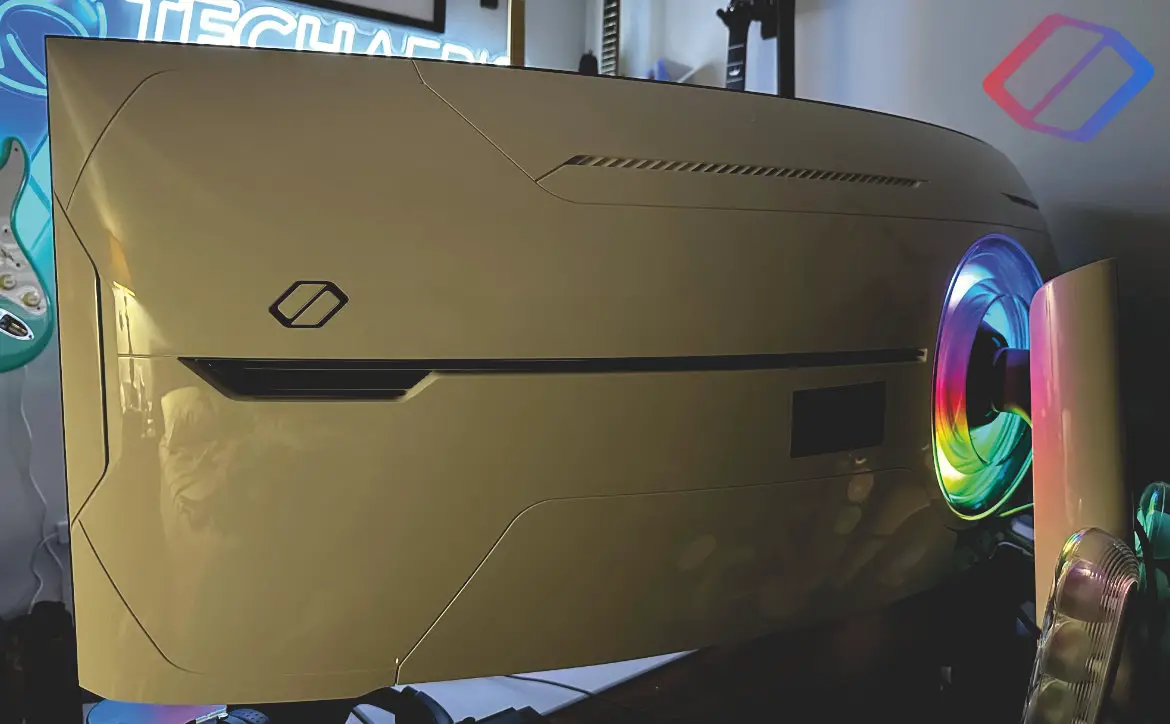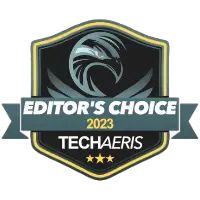
Samsung has been tearing up the pavement lately when it comes to gaming monitors. The 49″ Odyssey OLED G95SC released earlier this year was already impressive as it stood. But Samsung was not happy with this, so they came along to announce the 57″ Samsung Odyssey Neo G9 G95NC, the world’s first dual UHD monitor. The announcement was made in August with availability announced for October with a $2,499.99 price tag. Well, pre-orders are now live, and we have one of the first reviews of this insanely large monitor.
Estimated reading time: 18 minutes
The 57″ Samsung Odyssey Neo G9 G95NC not only brings basically two 32″ UHD monitors in one unit. But it also brings a 1000R curved screen, a 240Hz refresh rate, a 1ms response time, DisplayPort 2.1, AMD FreeSync, Mini LED backlighting, and of course, an insane 7680 × 2160 resolution.
A few housekeeping matters to get out of the way before we jump into this review. I am a casual gamer, which I think there are more of us than you can imagine, so you won’t get the nitty-gritty technical details in this review. If that’s what you’re looking for, then you’ll need to find another reviewer who does that sort of thing. I base my reviews on simple every day use by an everyday user, not hard core gaming blood use. I mostly tested the 57″ Samsung Odyssey Neo G9 G95NC using the new Alienware x16 and my Mac Mini M1. Furthermore, I used Steam and some Xbox Cloud gaming on PC for the gaming bits. I also tested video and photo editing on this display. So enough of that, let’s get into my review of the 57″ Samsung Odyssey Neo G9 G95NC.
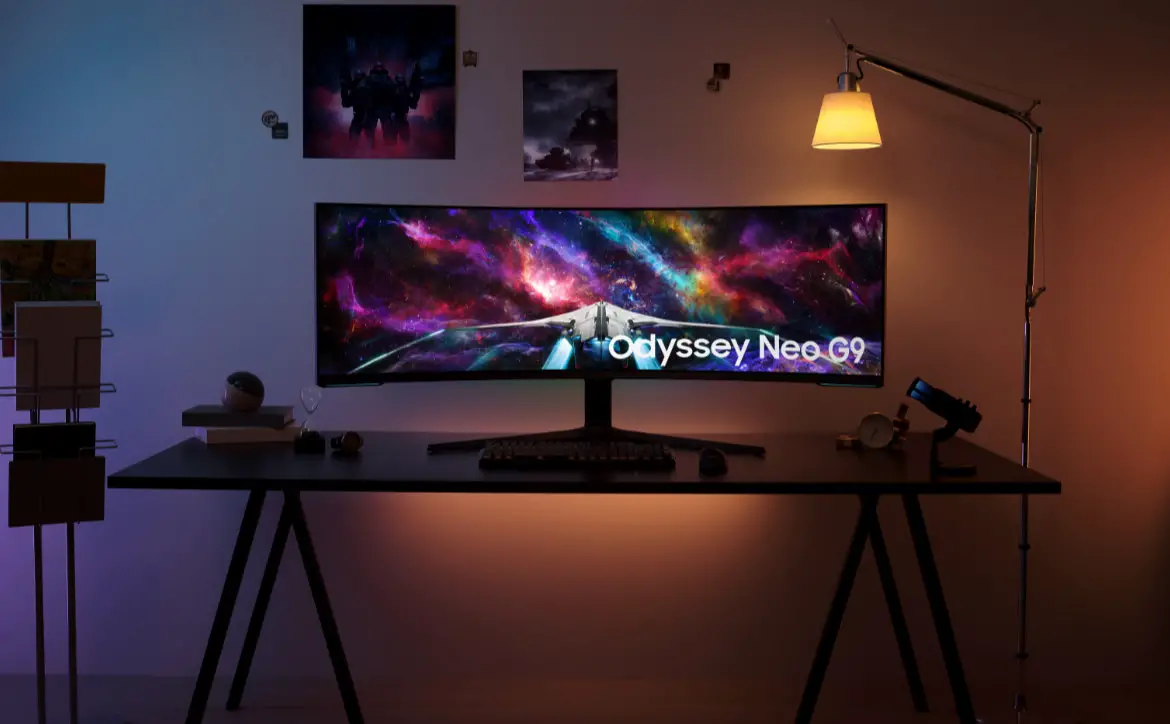
Table of contents
The Quick Take
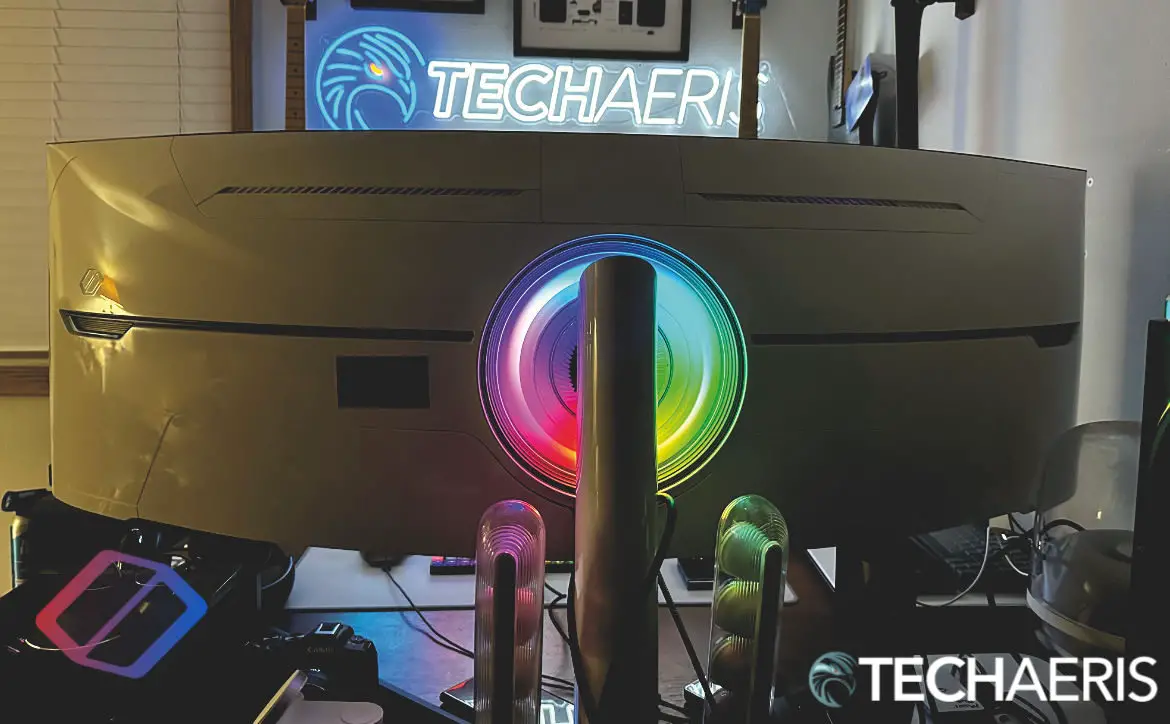
When I reviewed the 49″ Odyssey OLED, I kept this section short. That is not changing here, as this is an elementary quick take. But one thing that should be said right off the bat is this, you will need to have the hardware to support some of these features. Don’t expect to plug in your 8-year-old gaming laptop and get all the goodies here. Mac users should also know that you can use this with your Mac, but older Macs are out, and newer Macs are not going to get you the full resolution, or refresh rate.
The denser Mini LED display is spectacular and delivers great brightness, insane resolution, a wicked refresh rate, and fantastic response time. The 1000R curvature is actually welcome. The OLED version I reviewed has a 1800R curve and I thought that was just fine. But now, having used a similar monitor with the 1000R curve, I am convinced that the 1000R curve is superior.
Overall, the colors are vibrant, brightness is excellent, blacks are deep (though not as deep as the OLED G9), performance was spot on. One thing missing here, which isn’t a massive deal, is the Gaming Hub. Some users may want that, but it’s not a considerable deal to us. I highly recommend the Samsung Odyssey Neo G9 G95NC if you have the hardware to support it or are going to buy the hardware that supports it.
Specifications
The 57″ Samsung Odyssey Neo G9 G95NC has the following features and specifications:
| Model | LS57CG952NNXZA |
| Screen Size | 57″ Curved |
| Panel Type | Mini LED |
| Active Display Type (H × V) | 1394.6112 × 392.2344 mm |
| Aspect Ratio | 32:9 |
| Max Resolution | 7,680 × 2,160 |
| Screen Curvature | 1000R |
| Color Gamut (NTSC, 1976) | Unavailable at the time of posting |
| Brightness (Typical) | 420 cd/㎡ |
| Peak Brightness | 1,000 nits |
| HDR10+ | HDR10+ Gaming |
| HDR | VESA DisplayHDR 1000 |
| Color Support | Max 1B |
| Contrast Ratio | 2,500 : 1 (Static) |
| Lighting Control | Yes |
| Gaming Hub | NO |
| FreeSync | FreeSync Premium Pro |
| Tilt Range | -3.0º(± 2°) ~ 10.0º(± 2°) |
| Swivel Range | -15.0º (± 2°)~ 15.0º(± 2°) |
| Height Adjustable Stand | 120.0 mm(± 5.0 mm) |
| Response Time | 1ms(GTG) |
| Refresh Rate | Max 240Hz |
| Display Colors | Max 1B |
| Color Gamut | Typical 95% |
| Inputs/Outputs | HDMI 2.1 IN 120Hz, x3 HDMI IN, DisplayPort 2.1 IN, x2 USB 3.0, x 2 USB-B/KVM PC IN, 3.5 mm headphone jack |
| Power Consumption | 300W |
| Power Supply Type | AC100~240V ~50/60Hz |
| VESA mount (y/n, size) | 100 × 100 mm |
| Dimensions (with stand) | 1327.5 × 601.0 × 499.6 mm |
| Dimensions (without stand) | 1327.5 × 429.5 × 338.4 mm |
| Weight (with stand) | 19.0 kg |
| Weight (without stand) | 15.4 kg |
| Calibration | Factory Tuning, Factory Calibration Report |
| Color Modes | Entertain/Graphic/Eco/Game Standard/FPS/RTS/RPG/Sports/Original/Custom |
| MSRP | $2,499.99 |
What’s In The Box
- Samsung Odyssey Neo G9 G95NC
- Power Cable
- HDMI Cable
- DisplayPort Cable
- USB 3.0 Cable
- Manuals and Documentation
- Hardware
Design
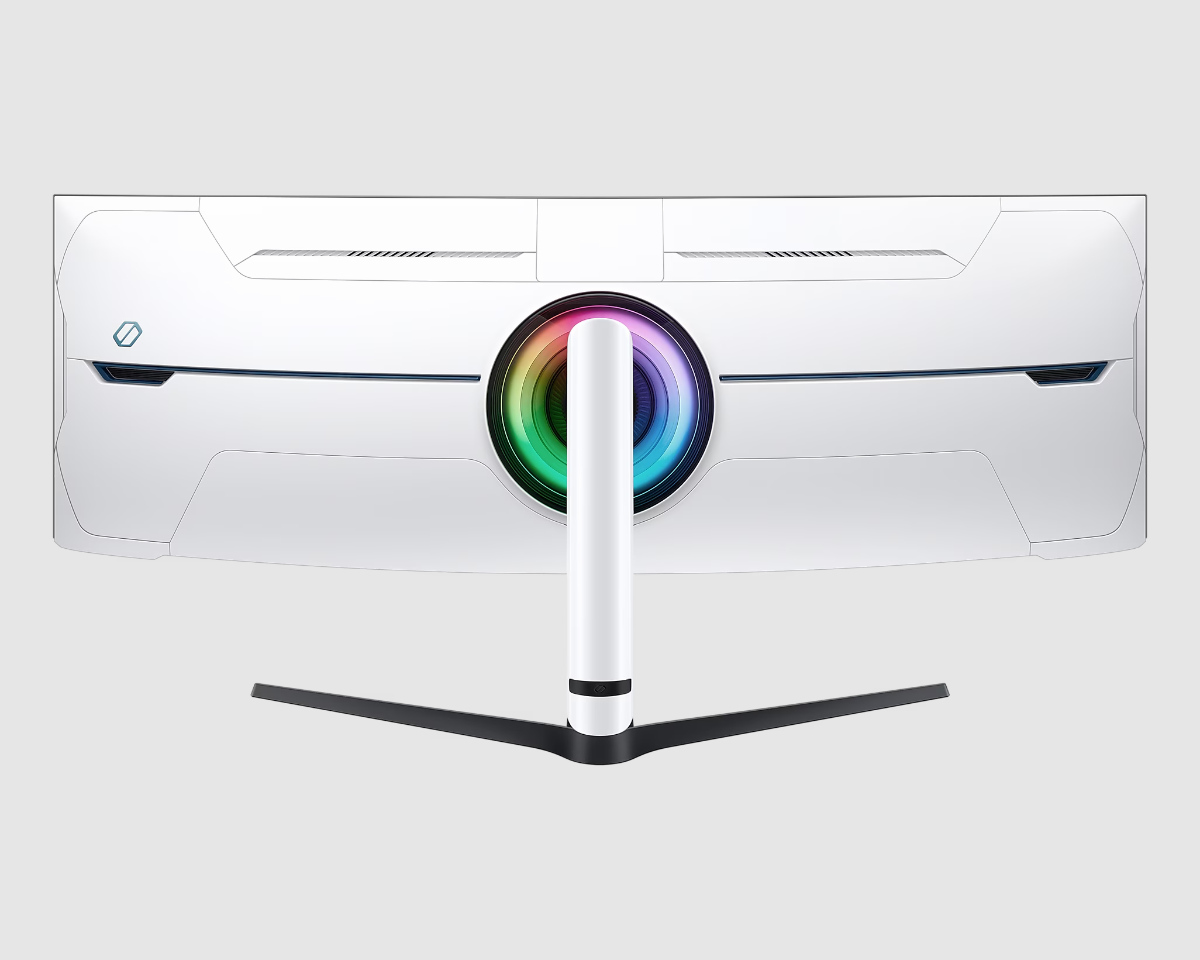
Samsung is not changing a huge number of things with the design of the Samsung Odyssey Neo G9 G95NC. The design language of the G9 is definitely here and present. Like previous G9’s, this unit has that 1000R curve and the Y shaped stand. I preferred the pedestal stand on the G9 OLED, but I suspect the reason to use the Y stand is for better stability due to more weight, though this unit is not super heavy. But compared to the OLED, well, yeah, you get the idea.
The biggest physical differences between the 49″ OLED and this 57″ Mini LED G9 is the 1000R curve. We covered this in our OLED review but it is worth talking about curves again. The chart below is a simple explanation of the curves on these new gaming monitors. The higher the number the less of a curve, the lower the number the more curved the display.
| Samsung G9 Curves | 1000R | 1800R |
| Curvature Depth | Pronounced Curve | Less pronounced curve |
| Gaming Experience (Subjective) | Excellent | Very Good |
| Viewing Angles | Is said to Match human eye viewing angles | The display has a less pronounced curve, sitting just outside human eye viewing angles. |
| The radius of the circle created by the monitor | 1 meter, otherwise known as 1000mm or 3.28ft | 1.8 meters, otherwise known as 1800mm or 5.9ft |
The simple explanation is that 1000R curved monitors wrap in closer to the user, which, in theory, gives the user a better experience and the ability to see more of the display without turning their head. There is much debate over this, I get an excellent experience from both 1000R and 1800R but since having the Samsung Odyssey Neo G9 G95NC for review, I am now leaning towards the 1000R camp is better.
OK, all of that nonsense out of the way, you are going to need a big desk for this beast. At least, if you don’t want it hanging over the sides, you’ll need a big desk. My desk measures 54″ in width and 30″ in depth, and this monitor takes all of that up end to end. If you don’t care if the ends hang over the sides of your desk, you will need at least 32″ in width and 16″ in depth (minimum) for the Y stand to hold your new monitor steady.
The bezels are thin, but it’s not like they are trying to be extremely thin, they just are what they are. The bottom bezel is slightly bigger, but really none of this is noticeable when using the monitor. The Samsung logo is center bottom and in a gloss black, it’s barely noticeable at all.
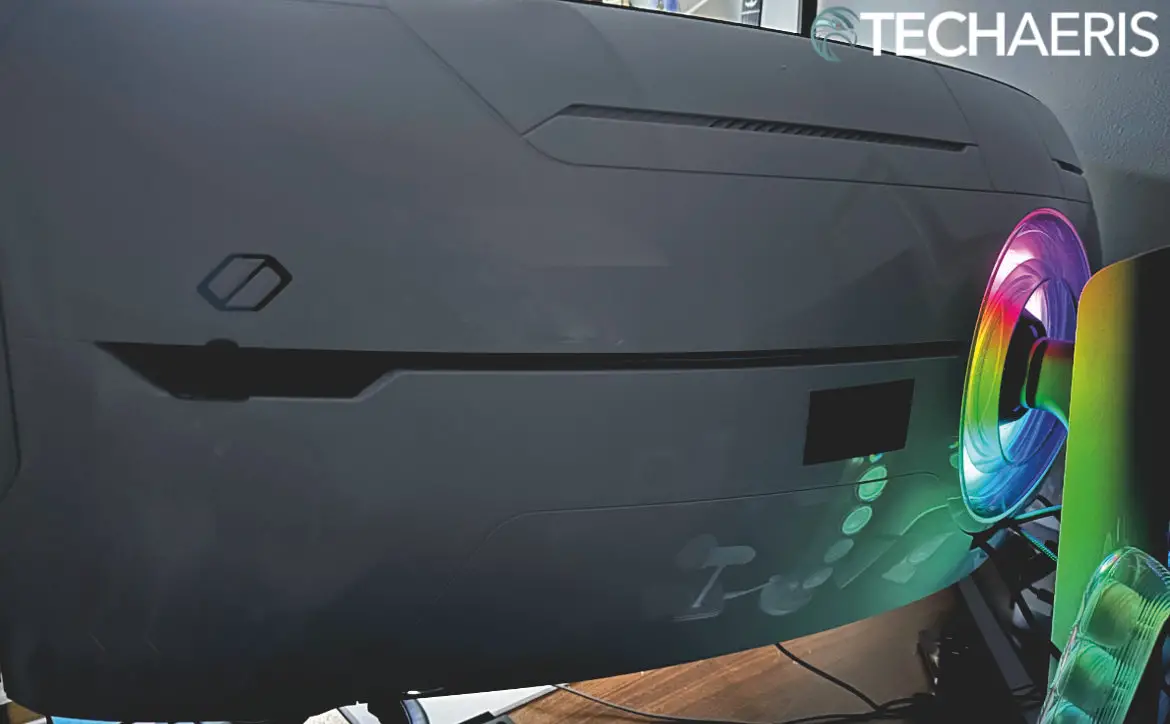
The monitor controls are tucked under that logo and are easy to reach and manipulate. It takes a few rounds of using the buttons to remember what’s what, but you eventually remember. There are also subtle lighting effects on the left and right bottom of the monitor, which mimic the core lighting on the back.
As mentioned, the Samsung Odyssey Neo G9 G95NC has the familiar Y-shaped stand which is robust and heavy. I would prefer a pedestal stand because it allows you more room to store things under the monitor but it is what it is. Cable management is done with a rubber loop, which works fine, but some neat freaks may disapprove.
Most of the Samsung Odyssey Neo G9 G95NC is up of high-quality plastics varying in color. The stand is made of metal with the spine covered in plastic. The back of the G95NC looks like its older brothers, with some nice accents running the length of the monitor and the Odyssey branding.
Like the other members of the G9 family, the Samsung Odyssey Neo G9 G95NC comes with the RGB core lighting on the back mounting area. It is brighter than the OLED version and can be seen better in a bright room, but, the effect is still better in a darker room. But let’s be serious, this is bling to show off and when the RGB core is facing others, it looks outstanding. You can control the lighting via the buttons and menu under the Samsung logo on the front.
As for the I/O, that is all tucked up under and around the RGB core and is set up like many other monitors. There is a large plastic cover that hides the cables fairly well, giving you a clean look. Here’s what you get for I/O: HDMI 2.1 IN 120Hz, x3 HDMI IN, DisplayPort 2.1 IN, x2 USB 3.0, x 2 USB-B/KVM PC IN, 3.5 mm headphone jack. The photo below gives you a better look at the I/O.
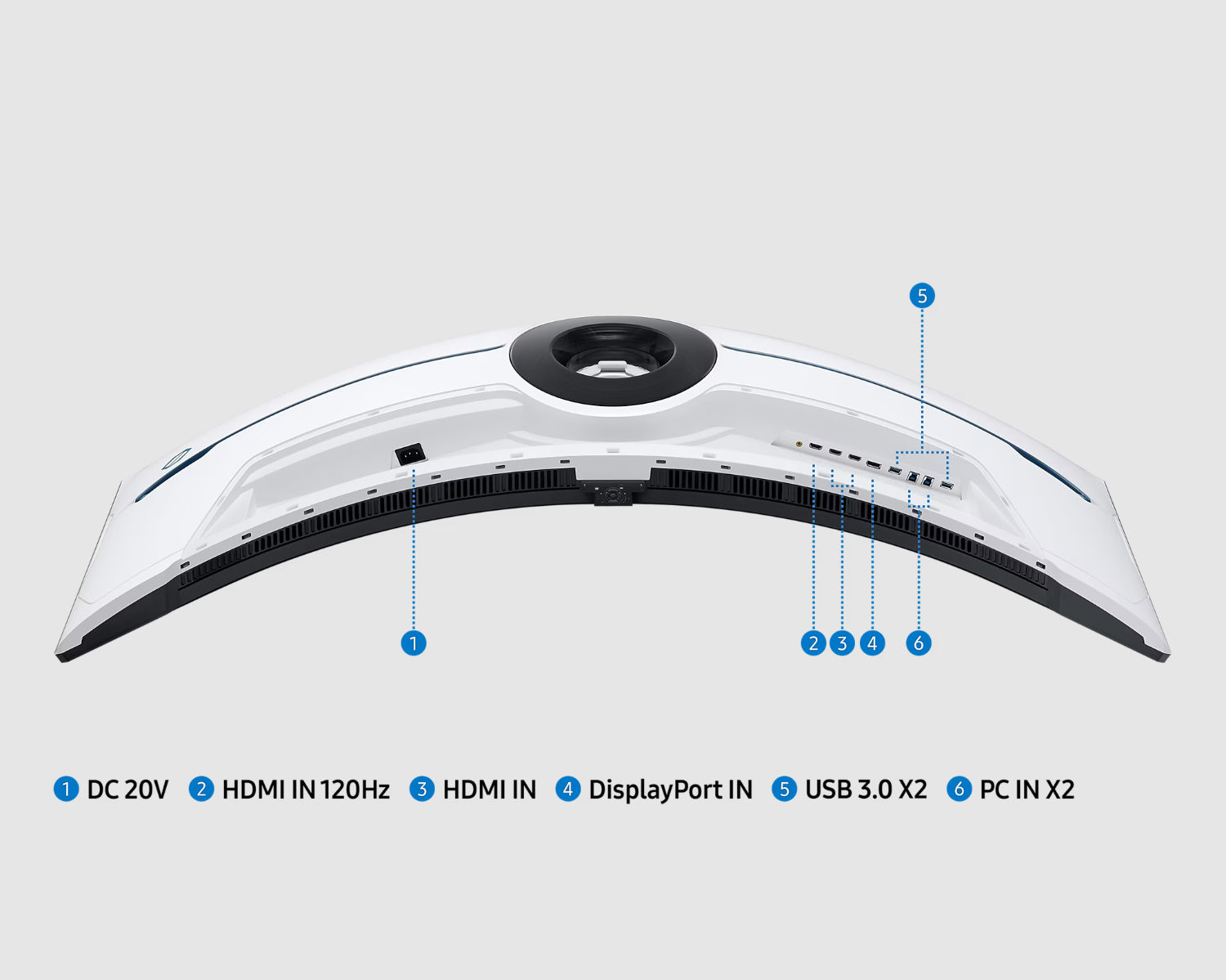
There are no speakers on this monitor, which I am perfectly fine with. Most gamers use gaming headphones and I am still using the Harmon Kardon Soundsticks from 2021.
Overall, Samsung didn’t do a lot to the aesthetics of Samsung Odyssey Neo G9 G95NC. It falls inline with its family members and that is not an issue because it looks spectacular. Yes, it is big, but that is part of the reason you’re even looking at it. It’s a fun and good-looking monitor and with the extra RGB features, it sets your desk apart from the rest of the crows.
Setup
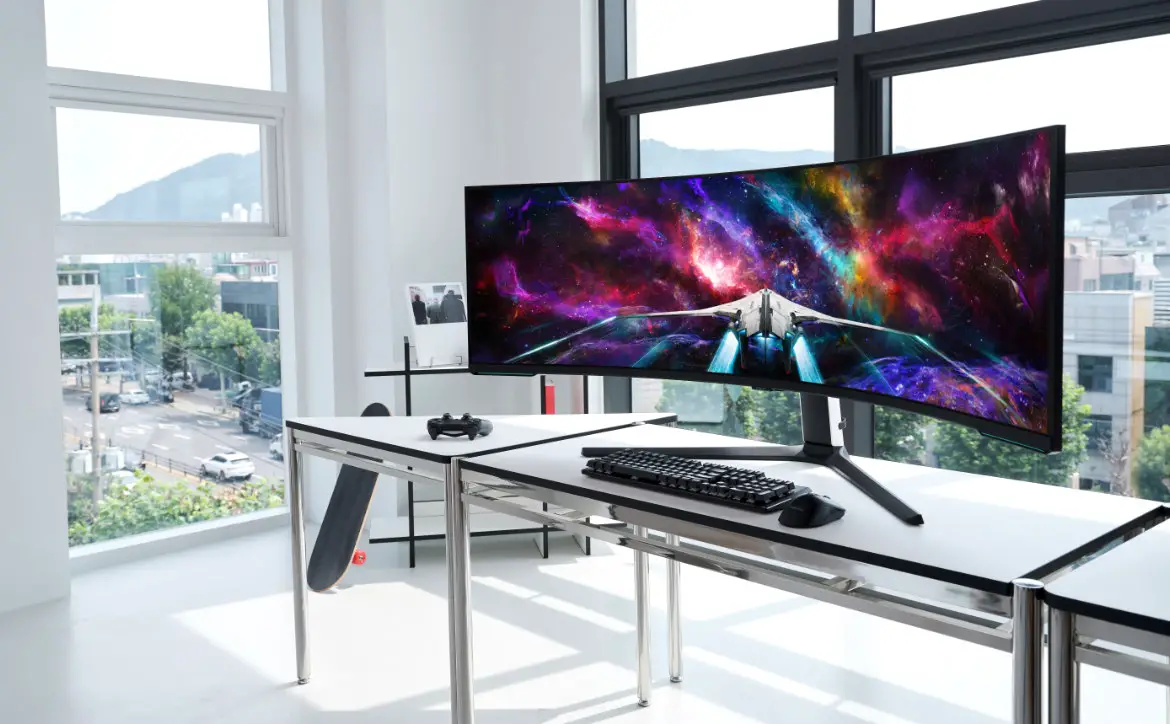
Physical setup of the Samsung Odyssey Neo G9 G95NC is a breeze. I will encourage you to have a second person help you. While it isn’t super heavy, it is heavy enough that having a second person is helpful. Better to be safe and not break your investment.
The stand comes in two pieces, the vertical portion and the foot. The foot screws into the stand and that portion of the assembly is done. The OLED G9 was a bit easier to put together because the stand just slipped into some tabs and locked into the back of the monitor. The G95NC requires you to screw the stand into the back of the monitor, not really that hard.
Once you have the stand screwed into the back, just be sure the plastic covers are locked into place, these will keep the RGB core’s aesthetic looking good. But be careful, those covers are finicky, and it took me a minute to get them in place, probably because I would rather not break anything and took my time.
All that’s left is to use the input of your choice, and off you go. Overall, this is a simple monitor to get put together and set up quickly.
Display
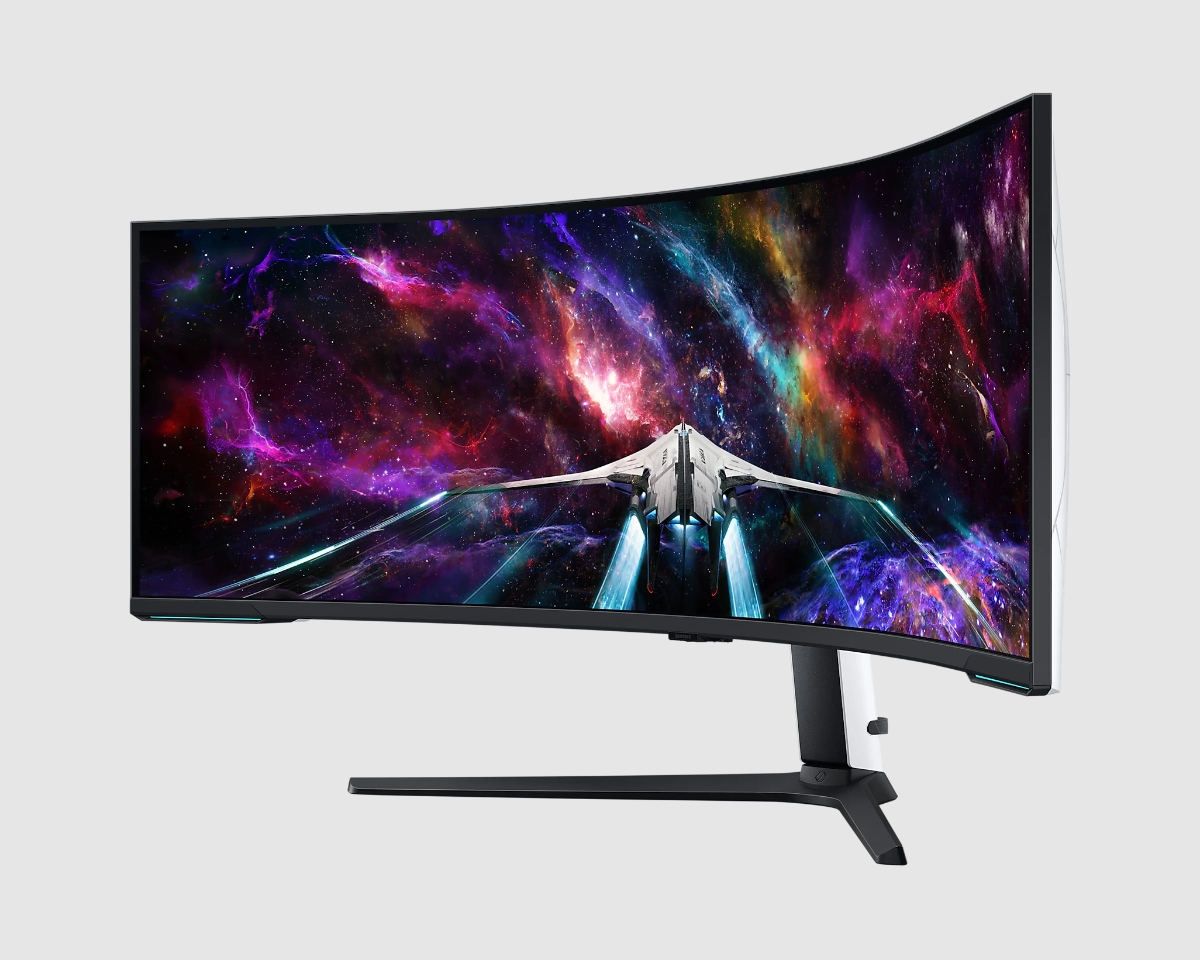
The Samsung Odyssey Neo G9 G95NC is the world’s first dual UHD monitor. For a better understanding, that’s like having two 32″ UHD (3840 × 2160) monitors side by side, except you don’t have the unsightly bezel in the middle. The finish of the display is a matte anti-glare finish that does great, keeping glare down to a minimum.
The display technology being used for this monitor is Quantum Mini LED tech. Quantum Matrix Technology with Quantum Mini LEDs creates controlled brightness and improved contrast for refined definition. 2,392 local dimming zones combined with 12-bit black levels put this puppy at another level.
Aside from the massive amount of real estate and that 1000 R curve, one of the biggest pros of this monitor is the peak brightness. The G95NC reveals details in superior ways. From the darkest shadows to bright daylight scenes, 1,000 nit peak brightness and 1,000,000:1 contrast ratio enable enhanced color expression and depth. It’s really something, and Mini LED is oh so close to OLED in the black levels, neck, and neck. The brightness levels are excellent though, using it in bright or dark rooms, it works fantastically.
Of course, everyone has their preference between OLED and Mini LED, thankfully Samsung has this 57″ Mini LED G9 and the 49″ OLED G9 to choose from. Either one of them is going to make you happy. I’ve already mentioned the 1000 R curve on the G95NC, but it is worth repeating that this curvature is immersive, putting you right in the action.
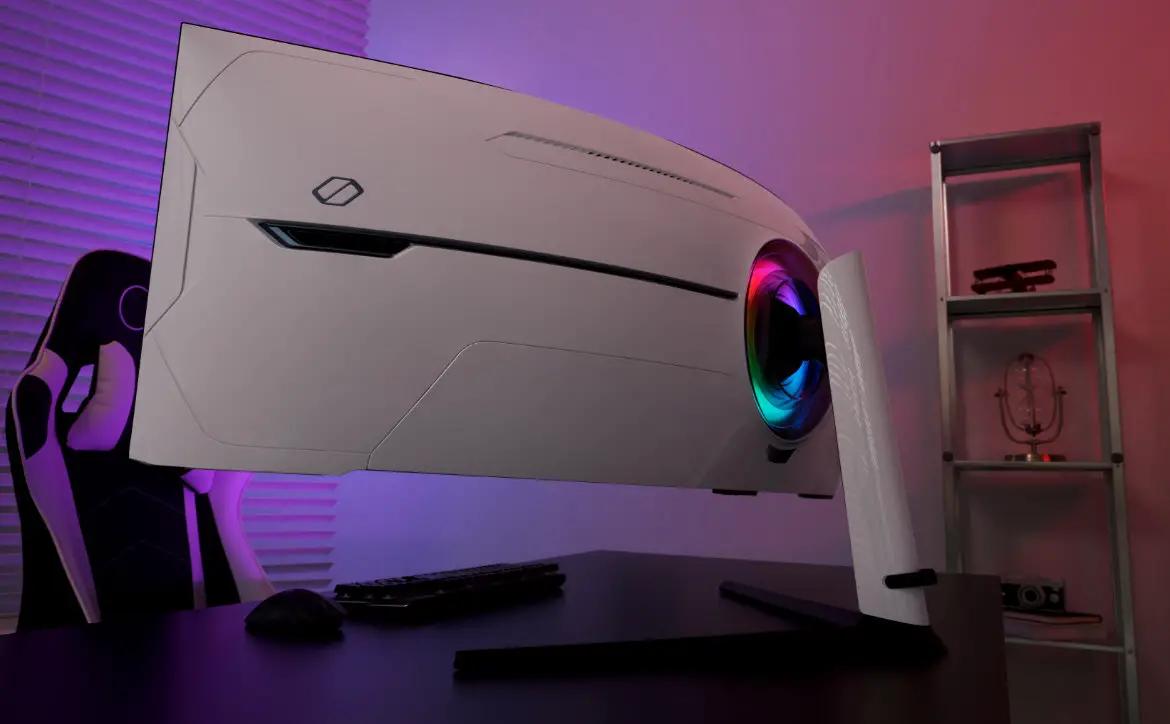
If your desktop or laptop supports it, you can plug into the DisplayPort 2.1 and experience 240Hz refresh rates with a 1ms response time. This is, of course, dependent on your hardware, cables, and games. I’m not a refresh rate or response time peeper. Being a photographer, I do pixel peep from time to time, so I do understand the need for this sort of performance if you’re into serious gaming.
So the power is there, for those who have the proper gear to support it. But what about the colors? Well, it’s a Samsung! Colors are popping off the screen, which you can adjust to your liking, of course. I am super impressed with Samsung’s Mini LED technology, it is so close to OLED in color and contrast. Like the G95SC, games are far more enveloping when the colors are nicely saturated, and they are on this monitor. The vibrancy of the monitor also makes it fantastic for consuming other media such as movies and TV shows, especially animated media.
This monitor also supports HDR content, and it displays it like a champ. Consuming movies and HDR media on this display was excellent. No complaints there at all.
The white levels are also crisp and clean, with no yellowing whatsoever. There were no signs of blooming or light bleed on our unit either. I should also mention that video and photo editing is incredible, especially video editing on such a wide display. Even wider than the 49″! The timeline can be seen for miles, reducing the amount of side scrolling needed to see the timeline. It’s a massive plus for video and photo editors.
Overall, Samsung has outdone itself with the Odyssey Neo G9 G95NC. Mini LED tech is impressive, allowing for amazing brightness without sacrificing colors and black levels.
Performance
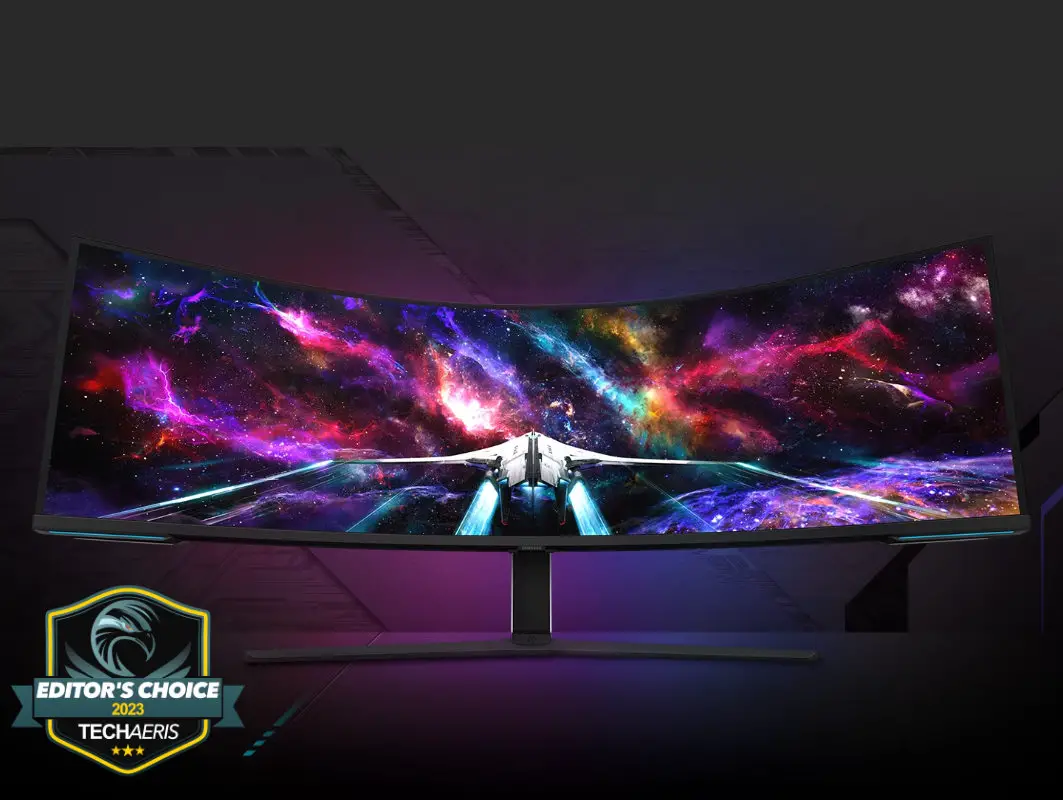
OK, let’s talk performance. You do need a powerful GPU to drive the 240Hz refresh rate, and many computers may not have this, probably none that you own. The RTX 4090 is one of the most powerful GPUs available today, if not the most powerful. But it does not have DisplayPort 2.1 which means 4090 users won’t see the full potential of this monitor.
The Alienware x16 we tested with does use the RTX 4090 and performance on the monitor was fantastic, though not at full potential. This is not the monitor’s fault, but rather, GPU’s are a little behind this display technology. But not all is lost. While you may struggle to get to that advertised performance level, with the 4090, you’re still getting 120Hz and maybe slightly better.
As I mentioned at the start of this review, I am a casual gamer, when I play games I do it to relax and not compete. The titles below are what my son and I used to test the Samsung Odyssey Neo G9 G95NC. We used Steam to play our gaming titles, I have access to Xbox Cloud Gaming, but our internet connection isn’t strong enough to use it without some issues. So, we stuck with Steam but we did a little with Xbox Cloud Gaming.
- Minecraft Dungeons
- Forza Horizon 4
- Call of Duty: WarZone
- Black Desert
- Star Wars Jedi: Fallen Order
- Batman: Arkham Asylum
- Destiny 2
One thing to realize, and I think most avid gamers are going to know this, but for those who do not know. Not all games are optimized or can be adjusted to use the G95SC’s 32:9 aspect ratio. Batman: Arkham Asylum was the first game I fired up and I was presented with chunky black bars to the left and right. Minecraft Dungeons works but needs to be optimized via the NVIDIA GeForce app and you will this to be the case on many games.
In real gaming situations, we noticed no lag, dropped frames or stutter in any of the titles we played. Everything ran smooth and we had no issues and enjoyed playing without interruption. While a more seasoned gamer would have played different titles, I think these were good enough to show me the capabilities of the G95NC.
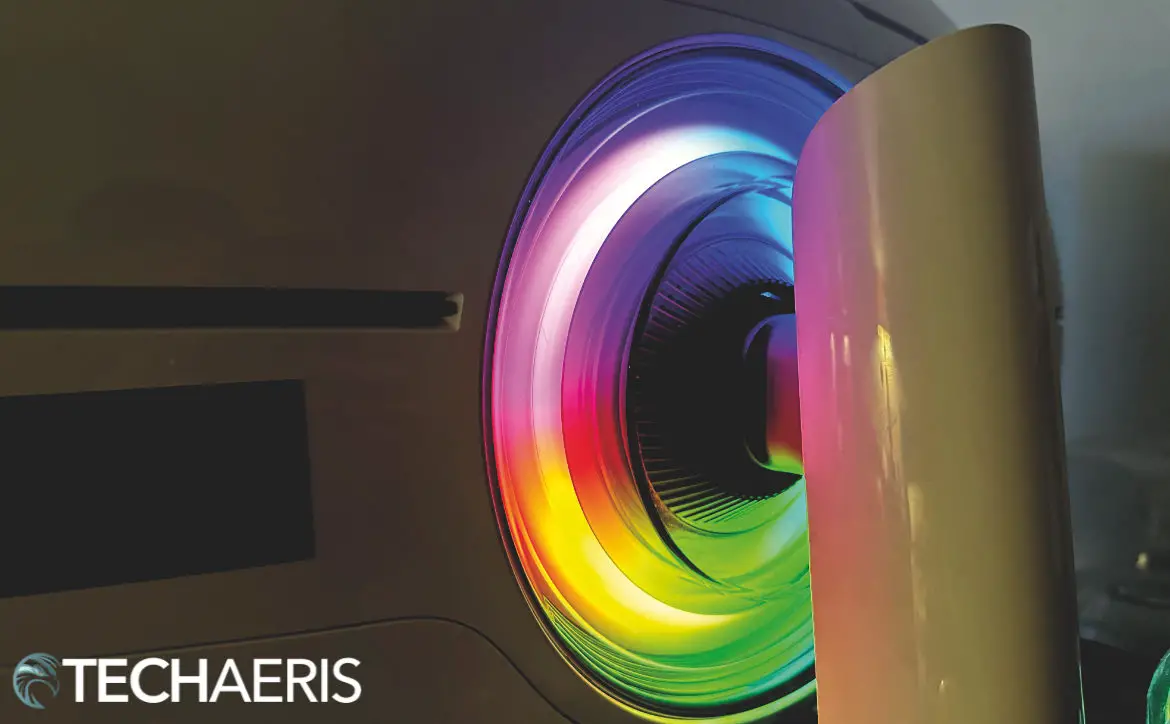
The KVM feature allows for hooking up two sources, basically having 2 32″ displays side by side with different sources, such as a PC and Xbox, or a PC and Mac. Speaking of Mac. I did use my Mac Mini M1 with the Samsung Odyssey Neo G9 G95NC and it was horrifying when plugged in through the HDMI port from the Mac Mini and into the HDMI port in the G95NC.
But, there is a way to make it work, albeit not at full resolution or refresh rate. With a DisplayPort 2.1 to Thunderbolt 3 cable, I was able to plug into the Mac Mini’s Thunderbolt 3 port to the Samsung’s DisplayPort 2.1 port and get a 120Hz refresh rate and HDR with a 5120 × 1440 resolution. So, this monitor is probably not ideal for Mac users, but it can be done.
As for everyday use, non-gaming. It works great. Though, I find it unusable at full resolution without scaling up to 250-300%. Unless you have super vision, the text is wicked small at 100% scaling at full resolution. But scaled up it all looks crisp, clear, and clean.
Video and photo editing is fantastic on this monitor. There is so much space for the timeline in videos and massive amounts of space for editing photos and having all of your workspace panels open. It’s just spectacular.
I used the included stand for my review unit but you can mount these on arms, but you may have some issues finding the proper adapters. Ergotron does make some so you might check their website but as far as we know, there is nothing that supports this particular monitor yet, but Ergotron will most likely be making something. We assume.
Overall, we felt the performance of the Samsung Odyssey Neo G9 G95NC was off the charts. It could be even better, if we had a stronger GPU to push the 240Hz refresh rate. But that’s not a huge issue as you will get 120Hz easily and possibly 144Hz if available on your hardware. The limitations aren’t Samsung’s fault, GPU hardware needs to catch up and perhaps software updates to existing GPUs might do that. I don’t know, we can only speculate. Still, performance is solid on the Samsung Odyssey Neo G9 G95NC and this is the best performance monitor you can get right now.
Price/Value
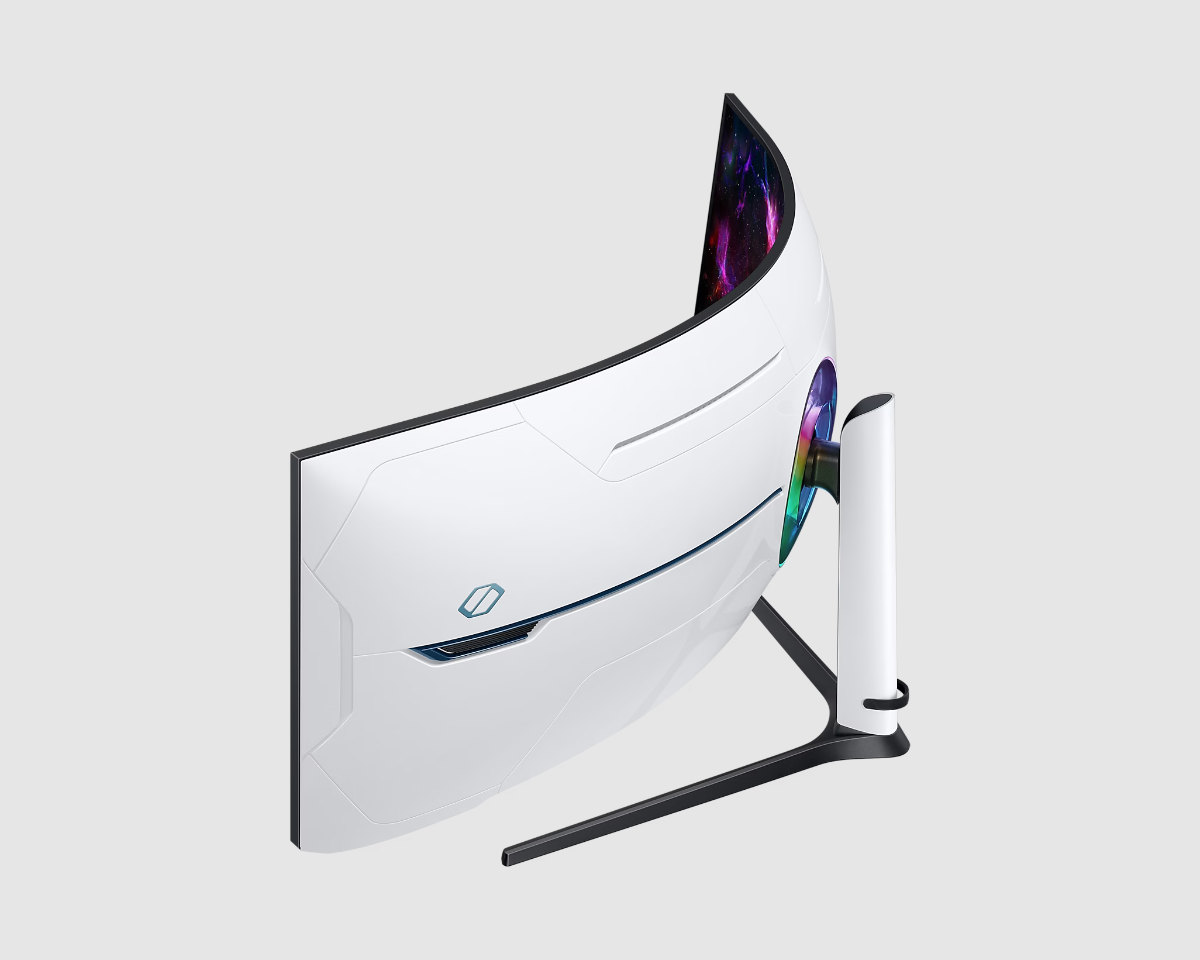
The announced price for the Samsung Odyssey Neo G9 G95NC was $2,499,99, which honestly shocked me. This monitor is a full 8″ bigger than the OLED version, which costs $2,199.99. Now, you may have to consider the display tech, OLED vs. Mini LED. But I think the extra $300 is worth getting the G95NC over the G95SC. The Mini LED tech and the higher resolution is worth it. In my eyes, anyway. I think Samsung priced this monitor very fairly and it is worth the asking price.
Samsung Odyssey Neo G9 57” is now available to pre-order on Samsung’s website, and those who pre-order between now and October 1 will receive a gift of $500 Samsung instant credit.
Wrap Up
Like its little brother, the 49″ G95SC, the 57″ big boy provides that immersive and enveloping experience that every avid gamer is after. The sheer size, resolution, color, contrast, and performance of this monitor delivers in spades! Gamers, if you’re in the market for a new gaming monitor, the Samsung Odyssey Neo G9 G95NC is the ONE to get! Of note, Mac users can use this but think twice as you won’t get the same performance out of it as a PC user. But it is still great to use on a Mac.
Samsung Odyssey Neo G9 G95NC
$2,499.99Nailed it
- The G9 design remains one of the nicest looking monitor designs on the market
- RGB ring and front LED accents add flair and are customizable
- Mini LED display is near OLED in quality with better peak brightness
- 240Hz refresh rate is perfect for gamers, provioded they have the hardware to run that rate
- I initally did not like the 1000R curve but I found it to be better than the 1800R on the OLED G9
- Display Port 2.1
- More than enough space for productivity work when your gaming sessions are over
- Easy setup and no software extras to worry about
- Price to value ratio is high
Needs work
- Due to limited GPU compatability, 240Hz may not work. But this is not the monitor's fault
- Only one Display Port 2.1, it would have been nice to have two of these
- I would have preferred a pedestal stand instead of the Y stand, but that's minor
- While we consider the price to be fair, some may find this to be pricey
In some of our articles and especially in our reviews, you will find Amazon or other affiliate links. As Amazon Associates, we earn from qualifying purchases. Any other purchases you make through these links often result in a small amount being earned for the site and/or our writers. Techaeris often covers brand press releases. Doing this does not constitute an endorsement of any product or service by Techaeris. We provide the press release information for our audience to be informed and make their own decision on a purchase or not. Only our reviews are an endorsement or lack thereof. For more information, you can read our full disclaimer.
Last Updated on March 13, 2024.

